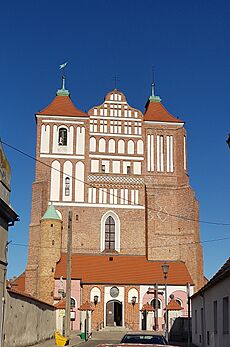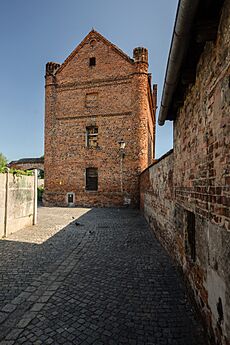Góra facts for kids
Quick facts for kids
Góra
|
|||
|---|---|---|---|

Rynek (Market Square) with monument to the heroes of the struggle for independent Poland
|
|||
|
|||
| Country | |||
| Voivodeship | Lower Silesian | ||
| County | Góra | ||
| Gmina | Góra | ||
| First mentioned | 1155 | ||
| Area | |||
| • Total | 13.65 km2 (5.27 sq mi) | ||
| Population
(2019-06-30)
|
|||
| • Total | 11,797 | ||
| • Density | 864.2/km2 (2,238.4/sq mi) | ||
| Time zone | UTC+1 (CET) | ||
| • Summer (DST) | UTC+2 (CEST) | ||
| Postal code |
56-200
|
||
| Vehicle registration | DGR | ||
| Voivodeship roads | |||
| Website | http://www.gora.com.pl | ||
Góra is a town in western Poland, located in the Lower Silesian Voivodeship. It is the main town for Góra County and the smaller area called Gmina Góra. The name "Góra" means "hill" or "mountain" in Polish. As of 2019, about 11,797 people live there.
Contents
Where is Góra?
Góra is found in the historic Lower Silesia region. It is about 69 kilometers (43 miles) north-west of Wrocław, which is the capital city of the region.
Góra's History
The area where Góra is located became part of the Polish state in the 10th century. The town was first mentioned in a document from 1155. This document was written by Pope Adrian IV. The name "Góra" means "hill" or "mountain" in the Polish language.
In 1256, a bishop named Tomasz I gave the village to a Polish knight. Later, in 1288, Góra became part of the Duchy of Głogów. It was then given special "town rights" by Duke Henry III. These rights helped the town grow and develop.
Growing as a Town
In 1300, Duke Henry III sold the local money-making place (mint) to the town council. The dukes gave Góra more special rights in 1306 and 1310. In 1310, 33 nearby villages became part of Góra's district.
From the 14th century, Góra became famous for making cloth. Special rules were made for the cloth makers in 1304. An annual fair was started in 1343, which helped the town's trade. A school was also first mentioned in Góra in that same year.
Góra remained under Polish rule for many centuries. It was part of different Polish duchies until the 16th century.
Later Years and Modern Times
In 1742, Góra became part of Prussia. Later, it was part of Germany from 1871 to 1945.
During World War II, the town was taken over by the Red Army in 1945. After the war, Góra became part of Poland again. Many Polish people who had been forced to leave their homes in eastern Poland moved to Góra. The town's original Polish name, Góra, was brought back.
Since 1999, the town has grown bigger. A nearby settlement called Sędziwojowice became part of Góra as its eastern district.
Famous People from Góra
- Benno Erdmann (1851–1921), a German philosopher.
- Wilhelm Klemm (1896–1985), a German scientist.
- Izabella Sierakowska (1946–2021), a Polish politician.
- Radosław Kałużny (born 1974), a Polish football player.
Sister Cities
To learn about Góra's sister cities, you can visit the page for Gmina Góra.
See also
 In Spanish: Góra para niños
In Spanish: Góra para niños





